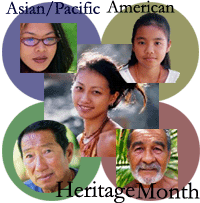|
|
 |
Highlights in Minority Health

|
MAY IS ASIAN/PACIFIC AMERICAN HERITAGE MONTH |
|
During the observance of Asian/Pacific American Heritage Month, we
celebrate the cultural traditions, ancestry, native languages, and
unique experiences represented among the more than 30 ethnic groups
from Asia and the Pacific who live in the United States. We also
recognize millions of Asian/Pacific Americans whose love of family,
hard work, and community has helped unite us as a people and sustain
us as a Nation. |
|
Asian American and Pacific Islanders represent one of the
fastest-growing and most diverse populations in the United States.
Asian Americans represent both extremes of socioeconomic and
health indices: while more than a million Asian Americans live at or
below the federal poverty level, Asian American women have the
highest life expectancy of any other group.
While Asian Americans and Pacific Islanders have the highest
proportion of college graduates of any race or ethnic group, they
suffer disproportionately from certain types of cancer, infectious
diseases, and other chronic diseases.
For instance, Vietnamese women have an incidence rate of cervical
cancer five times higher than white women, and Native Hawaiians are
2.5 times more likely to be diagnosed with diabetes than non-Hispanic
white residents of Hawaii. While the
rate of acute hepatitis B (HBV) among Asian Americans and Pacific
Islanders has been decreasing, the reported rate in 2001 was more than
twice as high among Asian Americans and Pacific Islanders (3.0 per
100,000) as among white Americans (1.3 per 100,000).
Factors contributing to poor health outcomes among Asian
Americans and Pacific Islanders include language and cultural
barriers, limited access to healthcare, poor nutrition,
and unhealthy behaviors. |
|
|
|
|

![]()
